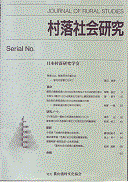The purpose of this paper is to examine the structure of the
yuimaru, that is, cooperative work through labor exchange in Kokuto production by small producers in Okinawa before the Second World War. The first of two aspects to be analyzed is the social system in Kokuto production, especially the structure of the
yuimaru. Secondly, the problem of the settlement of imbalances in labor exchanges among farmers in the
yuimaru system is examined.
We examined in detail reports and other documents dealing with the
yuimaru. In addition, we interviewed retired elderly farmers who had worked in
yuimaru.
Analysis of the above data led us to the following results. With regard to the first aspect, there were two types of farmers’ groups involved in Kokuto production. The larger groups were called
satougumi, which were subdivided into
kogumi. The farmers in a
satougumi were bound together by a shared territory. They managed sugar mills(either animal- or hydraulically- powered)and open pans and scheduled Kokuto production for each farmer. Each
kogumi consisted of seven or eight farmers who worked together to produce Kokuto. These members formed the
yuimaru. They were either relatives by blood or marriage, or neighbors or friends. These relationships were between peers as opposed to the hierarchical relationships of the
ie, the family system based on patriarchy in prewar Japan.
The second aspect, the settlement of imbalances in labor exchanges in the
yuimaru, was addressed only incompletely with inconclusive results.
In addition, we can conclude that even though the bonds within the
yuimaru were between individuals, they did not represent relationships established by independent persons. Rather, the bonds constituted a type of social relationship which existed prior to the formation of the
ie.
抄録全体を表示
